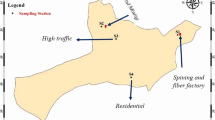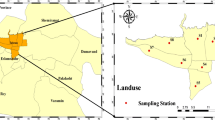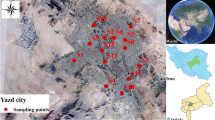Abstract
Asbestos, as with other pollutants in the air, has adverse effects on the health of human beings and animals. Today, the relationship between presence of asbestos fibers in the air breathed by humans and developing serious diseases such as lung cancer (asbestosis) and mesothelioma has been proven. The objectives of this study were to monitor the levels of asbestos fibers in ambient air of Mashhad, Iran during 2018, and to draw its Geographic Information System (GIS) distribution map for the city. In this descriptive study, 13 sampling points in Mashhad city were chosen. Sampling of asbestos was carried out for 3 hour during summer and winter at 2018. Sampling of asbestos was performed using MCE (Mixed Cellulose Ester) membrane filters (pour size 0.45 µm; diameter: 25 mm) and cassette holder and peripheral pump. The samples were the analyzed by the phase contrast microscopy (PCM) method (NIOSH7400). Also, to investigate the type of asbestos and for more accurate counting of fibers, Scanning Electron Microscopy (SEM) analysis was utilized. Meteorological parameter were recorded through portable devices. To draw the graphs, Excel, R and Arc GIS software were used. Results showed that the mean asbestos fiber concentrations were equal to 11.40 ± 2.14 and 14.38 ± 2.52 f/L in summer and winter, respectively. The maximum level of asbestos fiber was detected in the station of Baitolmoghaddas square by 26.64 ± 2.14 and 19.3 SEM f/L in winter and summer, respectively. High concentration of asbestos fiber observed in this study can be attributed to the heavy traffic, the presence of prominent industries in the vicinity of the study area, and topographic features. The results from this research recommends that suitable controlling policies should be regulated to reduce both ambient air asbestos and its adverse health endpoints in Mashhad.





Similar content being viewed by others
References
Mokhtari M, et al. Assessment of airborne asbestos fibers concentration in Yazd city in summer 2015. J Environ Health Sustain Dev. 2016;1(2):75–81.
Fathi Fathabadi MK, et al. Spatio-seasonal variation of airborne asbestos concentration in urban areas of Shiraz, Iran. Int J Occup Environ Health. 2017;23(2):143–50.
Nabizadeh R, Yousefi M, Azimi F. Study of particle number size distributions at Azadi terminal in Tehran, comparing high-traffic and no traffic area. MethodsX. 2018;5:1549–55.
Guthrie GD Jr, Mossman BT. Health effects of mineral dusts. Vol. 28. Berlin: Walter de Gruyter GmbH & Co KGWalter de Gruyter GmbH & Co KG; 2018.
Kermani M, et al. Association between meteorological parameter and PM2. 5 concentration in Karaj, Iran. Int J Environ Health Eng. 2020;9(1):4.
Kakooei H, Sameti M, Kakooei AA. Asbestos exposure during routine brake lining manufacture. Ind Health. 2007;45(6):787–92.
Ghorbani S, Hajizadeh Y. Monitoring of airborne asbestos fiber concentrations in high traffic areas of Isfahan, Iran in summer 2015. Int J Environ Health Eng. 2016;5(1):8.
Marioryad H, et al. Assessment of airborne asbestos exposure at an asbestos cement sheet and pipe factory in Iran. Regul Toxicol Pharmacol. 2011;60(2):200–5.
Tarone RE. On the International Agency for Research on Cancer classification of glyphosate as a probable human carcinogen. Eur J Cancer Prev. 2018;27(1):82–7.
Heydari G, et al. Load characteristics and inhalation risk assessment of benzene series (BTEX) pollutant in indoor air of Ghalyan and/or cigarette cafes compared to smoking-free cafes. Environ Pollut Bioavailab. 2020;32(1):26–35.
Taghizadeh F, et al. Monitoring of airborne asbestos fibers in an urban ambient air of Shahryar City, Iran: levels, spatial distribution, seasonal variations, and health risk assessment. Environ Sci Pollut Res. 2019;26(7):6450–9.
Khadem M, et al. Joint Iranian-Russian studies of airborne asbestos concentrations in Tehran, Iran, in 2017. Atmos Environ. 2018;186:9–17.
Kakooei H, Meshkani M, Azam K. Ambient monitoring of airborne asbestos in non-occupational environments in Tehran, Iran. Atmos Environ. 2013;81:671–5.
Ghorbani S, et al. Spatio-temporal variations of asbestos fibres levels in ambient air of a densely populated and industrialized city of Iran. Int J Environ Anal Chem. 2020: p. 1–9.
Mirzaei R, et al. Determination of airborne concentration and type of asbestos fibers in high-traffic areas of Zahedan City. Arch Occup Health. 2019;3(4):452–9.
Bourdès V, Boffetta P, Pisani P. Environmental exposure to asbestos and risk of pleural mesothelioma: review and meta-analysis. Eur J Epidemiol. 2000;16(5):411–7.
Fernandes GA, et al. Lung cancer mortality trends in a Brazilian City with a long history of asbestos consumption. Int J Environ Res Public Health. 2019;16(14):2548.
Leocat E. Naturally occurring asbestos in France: a technical and regulatory review. Environ Eng Geosci. 2020;26(1):61–5.
Bourgault M-H, Gagné M, Valcke M. Lung cancer and mesothelioma risk assessment for a population environmentally exposed to asbestos. Int J Hyg Environ Health. 2014;217(2–3):340–6.
Oskierski H, et al. Chemical and isotopic signatures of waters associated with the carbonation of ultramafic mine tailings, Woodsreef Asbestos Mine, Australia. Chem Geol. 2016;436:11–23.
Lim H-S, et al. Airborne asbestos and non-asbestos fiber concentrations in non-occupational environments in Korea. Ind Health. 2004;42(2):171–8.
Miri M, et al. Mortality and morbidity due to exposure to outdoor air pollution in Mashhad metropolis, Iran. The AirQ model approach. Environ Res. 2016;151:451–7.
Benner TC. Brief survey of EPA standard-setting and health assessment. Washington, D.C: ACS Publications; 2004.
Kusiorowski R, et al. Thermal decomposition of different types of asbestos. J Therm Anal Calorim. 2012;109(2):693–704.
Lee R, Van Orden D. Airborne asbestos in buildings. Regul Toxicol Pharmacol. 2008;50(2):218–25.
Maule MM, et al. Modeling mesothelioma risk associated with environmental asbestos exposure. Environ Health Perspect. 2007;115(7):1066–71.
Militello GM, et al. The concentration of asbestos fibers in bulk samples and its variation with grain size. Minerals. 2019;9(9):539.
Hajizadeh Y, et al. Protocol for identification of airborne asbestos fibres in the urban areas and spatio-temporal trend. MethodsX. 2019;6:2237–41.
Kazan-Allen L. Asbestos and mesothelioma: worldwide trends. Lung Cancer. 2005;49:S3–8.
Vimercati L, et al. Environmental asbestos exposure and mesothelioma cases in Bari, Apulia region, southern Italy: a national interest site for land reclamation. Environ Sci Pollut Res. 2018;25(16):15692–701.
Gualtieri AF, et al. Ambient monitoring of asbestos in selected Italian living areas. J Environ Manag. 2009;90(11):3540–52.
Mokhtari M, et al. Temporal and spatial trends of airborne asbestos fiber concentrations in the urban areas of Yazd, Iran. Int J Environ Sci Technol. 2019;16(6):2657–66.
Gandolfi NB, et al. Assessment of asbestos body formation by high resolution FEG–SEM after exposure of Sprague–Dawley rats to chrysotile, crocidolite, or erionite. J Hazard Mater. 2016;306:95–104.
Garabrant DH, Pastula ST. A comparison of asbestos fiber potency and elongate mineral particle (EMP) potency for mesothelioma in humans. Toxicol Appl Pharmcol. 2018;361:127–36.
Gadikota G, et al. Morphological changes during enhanced carbonation of asbestos containing material and its comparison to magnesium silicate minerals. J Hazard Mater. 2014;264:42–52.
Hajizadeh Y, et al. Concentrations and mortality due to short-and long-term exposure to PM 2.5 in a megacity of Iran (2014–2019). Environ Sci Pollut Res. 2020: p. 1–11.
Acknowledgements
The authors received financial and technical support for this research from Mashhad University of Medical Sciences. We would like to express our thanks to the Air Quality Control Company (AQCC) of Mashhad for providing air pollutants data.
Author information
Authors and Affiliations
Corresponding author
Ethics declarations
Conflict of interest
The authors of this article declare that they have no conflict of interests.
Ethical considerations
The authors of this article have covered all the ethical points, including non-plagiarism, duplicate publishing, data distortion, and data creation in this article.
Additional information
Publisher's Note
Springer Nature remains neutral with regard to jurisdictional claims in published maps and institutional affiliations.
Rights and permissions
About this article
Cite this article
Moteallemi, A., Minaei, M., Tahmasbizadeh, M. et al. Monitoring of airborne asbestos fibers in an urban ambient air of Mashhad City, Iran: levels, spatial distribution and seasonal variations. J Environ Health Sci Engineer 18, 1239–1246 (2020). https://doi.org/10.1007/s40201-020-00541-5
Received:
Accepted:
Published:
Issue Date:
DOI: https://doi.org/10.1007/s40201-020-00541-5




